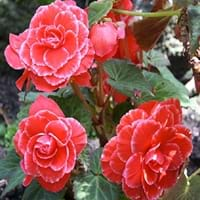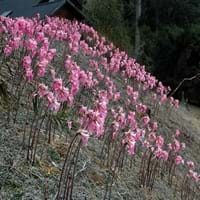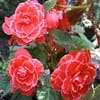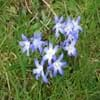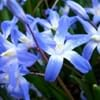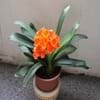Life Span
Perennial
Annual
Type
Bulb or Corm or Tuber
Bulb or Corm or Tuber
Origin
Hybrid origin
South Africa
Types
'Bellagio Apricot' begonia, 'Bellagio Blush' begonia, 'Bellagio Pink' begonia
Barberton, Cape Town, Elator
Number of Varieties
Not Available
Habitat
Subtropical climates, Tropical regions
Warmer regions
USDA Hardiness Zone
9-15
6-10
Habit
Clump-Forming
Clump-Forming
Flower Color
Salmon
Pink, Rose
Flower Color Modifier
Bicolor
Bicolor
Fruit Color
Not Available
Not Available
Leaf Color in Spring
Green
Dark Green
Leaf Color in Summer
Light Green
Light Green
Leaf Color in Fall
Several shades of Green
Several shades of Green
Leaf Color in Winter
Light Green
Light Green
Leaf Shape
Heart-shaped
Narrow
Plant Season
Summer, Fall
Summer
Sunlight
Partial shade
Full Sun, Partial Sun, Partial shade
Growth Rate
Medium
Medium
Type of Soil
Loam, Sand
Loam, Sand
The pH of Soil
Acidic, Neutral
Acidic, Neutral
Soil Drainage
Well drained
Well drained
Bloom Time
Early Summer, Summer, Late Summer
Summer, Late Summer
Tolerances
Not Available
Drought
Where to Plant?
Container, Ground, Pot
Container, Ground, Pot
How to Plant?
Seedlings, Transplanting
Seedlings
Plant Maintenance
Medium
Medium
Watering Requirements
Over-watering can cause leaf problems or root diseases, Requires regular watering, Water Deeply
Average Water Needs, Do Not over Water, Requires regular watering
In Summer
Lots of watering
Lots of watering
In Spring
Moderate
Moderate
In Winter
Average Water
Average Water
Soil pH
Acidic, Neutral
Acidic, Neutral
Soil Type
Loam, Sand
Loam, Sand
Soil Drainage Capacity
Well drained
Well drained
Sun Exposure
Partial shade
Full Sun, Partial Sun, Partial shade
Pruning
Cut or pinch the stems, No pruning needed in the early stages, Prune if you want to improve plant shape, Prune to control growth, Remove dead or diseased plant parts
Remove damaged leaves, Remove dead branches, Remove dead leaves
Fertilizers
All-Purpose Liquid Fertilizer
All-Purpose Liquid Fertilizer
Pests and Diseases
Aphids, Bacterial leaf spot, Botrytis Blight, Foliar nematode, Powdery mildew, Pythium rot, Rhizoctonia crown rot
Red blotch
Plant Tolerance
Drought
Drought
Flower Petal Number
Double
Single
Foliage Texture
Coarse
Medium
Foliage Sheen
Glossy
Glossy
Attracts
Not Available
Butterflies, Hummingbirds
Allergy
Asthma
Abdominal pain, Depression, Diarrhea, Toxic, Vomiting
Aesthetic Uses
Beautification
Showy Purposes
Beauty Benefits
Not Available
Not Available
Edible Uses
Yes
Insignificant
Environmental Uses
Air purification
Air purification
Medicinal Uses
Bronchitis, Candidiasis, Cold, Digestive disorders, Dysentry, Haemoptysis, Liver problems, Menstrual Disorders, Scrofula, Swelling
Not Available
Part of Plant Used
Whole plant
Flowers
Other Uses
Used as Ornamental plant
Showy Purposes
Used As Indoor Plant
Yes
Insignificant
Used As Outdoor Plant
Yes
Yes
Garden Design
Bedding Plant, Container, Hanging Basket, Houseplant, Tropical
Container, Cutflower, Feature Plant, Houseplant, Mixed Border, Rock Garden / Wall
Botanical Name
BEGONIA 'Fortune Salmon'
AMARYLLIS belladonna
Common Name
Fortune Salmon Tuberous Begonia, Tuberous Begonia
August Lily, Belladonna Lily, Naked Lady
In Hindi
tuberous बिगोनिया
Belladonna Lily plant
In German
Knollenbegonie
Belladonna Lily Pflanze
In French
Bégonia tubéreux
Belladonna Lily plante
In Spanish
Begonia tuberosa
planta de lirio de belladona
In Greek
Οζώδους Begonia
φυτό Belladonna Lily
In Portuguese
tuberosa Begonia
planta Belladonna Lily
In Polish
Begonia guzowate
Belladonna Lily roślin
In Latin
Morbus Begonia
Lilium planta belladonna
Phylum
Magnoliophyta
Magnoliophyta
Class
Magnoliopsida
Liliopsida
Order
Cucurbitales
Liliales
Family
Begoniaceae
Amaryllidaceae
Clade
Angiosperms, Eudicots, Rosids
Angiosperms, Monocots
Tribe
Not Available
Not Available
Subfamily
Not Available
Amaryllidoideae
Number of Species
Not Available
Difference Between Tuberous Begonia and Belladonna Lily
If you are confused whether Tuberous Begonia or Belladonna Lily are same, here are some features about those plants to help you choose better. Many people think that these two plants have the same characteristics, but one can see Tuberous Begonia and Belladonna Lily Information and learn more about it. Fertilizers required for proper growth of Tuberous Begonia are All-Purpose Liquid Fertilizer, whereas for Belladonna Lily fertilizers required are All-Purpose Liquid Fertilizer. Hence, one should know the basic difference between Tuberous Begonia and Belladonna Lily if you are planning to have them in your garden to enhance its beauty.
<
Flowering PlantsImportance of Tuberous Begonia and Belladonna Lily
Want to have the most appropriate plant for your garden? You might want to know the importance of Tuberous Begonia and Belladonna Lily. Basically, these two plants vary in many aspects. Compare Tuberous Begonia and Belladonna Lily as they differ in many characteristics such as their life, care, benefits, facts, etc. Every gardener must at least have the slightest clue about the plants he wants to plant in his garden. Compare their benefits, which differ in many ways like facts and uses. The medicinal use of Tuberous Begonia is Bronchitis, Candidiasis, Cold, Digestive disorders, Dysentry, Haemoptysis, Liver problems, Menstrual Disorders, Scrofula and Swelling whereas of Belladonna Lily is Not Available. Tuberous Begonia has beauty benefits as follows: Not Available while Belladonna Lily has beauty benefits as follows: Not Available.
Compare Facts of Tuberous Begonia vs Belladonna Lily
How to choose the best garden plant for your garden depending upon its facts? Here garden plant comparison will help you to solve this query. Compare the facts of Tuberous Begonia vs Belladonna Lily and know which one to choose. As garden plants have benefits and other uses, allergy is also a major drawback of plants for some people. Allergic reactions of Tuberous Begonia are Asthma whereas of Belladonna Lily have Abdominal pain, Depression, Diarrhea, Toxic and Vomiting respectively. Having a fruit bearing plant in your garden can be a plus point of your garden. Tuberous Begonia has no showy fruits and Belladonna Lily has no showy fruits. Also Tuberous Begonia is not flowering and Belladonna Lily is flowering. You can compare Tuberous Begonia and Belladonna Lily facts and facts of other plants too.
